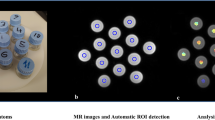Abstract
Objective
To investigate the sensitivity of modified Look–Locker inversion recovery (MOLLI) to measure changes in dissolved oxygen (DO) concentrations in water samples and to calculate sequence-specific relaxivity (r1m) and limit of detection (LOD).
Materials and methods
Ten water samples with a range of DO concentrations were scanned at 3 T using two variations of MOLLI schemes. Using linear regression the r1 of DO was estimated from the measured DO concentrations and T1 relaxation rates (R1). The results were combined with previously reported values on in vivo stability measures of the MOLLI sequences and used to estimate a LOD.
Results
DO concentrations ranged from 0.5 to 21.6 mg L−1. A linear correlation between DO and R1 was obtained with both MOLLI sequences, with an average correlation coefficient (R2) 0.9 and an average estimated r1 (\(\hat{r}_{1}\)) of 4.45 × 10−3 s−1 mg−1 L. Estimated LOD was ≈ 10 mg L−1.
Conclusion
MOLLI T1-mapping sequences may be used for detecting dissolved oxygen in vivo at 3 T with an \(\hat{r}_{1}\) in the range 4.18–4.8 × 10−3 s−1 mg−1 L and a corresponding LOD for dissolved oxygen of approximately 10 mg L−1. MOLLI-based T1 mapping may be a useful non-invasive tool for quantification of in vivo changes of DO concentration during oxygen challenges.



Similar content being viewed by others
References
Muir ER, Zhang Y, San Emeterio Nateras O, Peng Q, Duong TQ (2013) Human vitreous: MR imaging of oxygen partial pressure. Radiology 266(3):905–911
Mehemed TM, Fushimi Y, Okada T, Yamamoto A, Kanagaki M, Kido A, Fujimoto K, Sakashita N, Togashi K (2014) Dynamic oxygen-enhanced MRI of cerebrospinal fluid. PLoS ONE 9(6):e100723
Jones RA, Ries M, Moonen CT, Grenier N (2002) Imaging the changes in renal T1 induced by the inhalation of pure oxygen: a feasibility study. Magn Reson Med 47(4):728–735
O’Connor JP, Jackson A, Buonaccorsi GA, Buckley DL, Roberts C, Watson Y, Cheung S, McGrath DM, Naish JH, Rose CJ, Dark PM, Jayson GC, Parker GJ (2007) Organ-specific effects of oxygen and carbogen gas inhalation on tissue longitudinal relaxation times. Magn Reson Med 58(3):490–496
Zhang Z, Yuan Q, Zhou H, Zhao D, Li L, Gerberich JL, Mason RP (2015) Assessment of tumor response to oxygen challenge using quantitative diffusion MRI in an animal model. J Magn Reson Imaging 42(5):1450–1457
Zaharchuk G, Busse RF, Rosenthal G, Manley GT, Glenn OA, Dillon WP (2006) Noninvasive oxygen partial pressure measurement of human body fluids in vivo using magnetic resonance imaging. Acad Radiol 13(8):1016–1024
Beeman SC, Shui Y-B, Perez-Torres CJ, Engelbach JA, Ackerman JJH, Garbow JR (2016) O2-sensitive MRI distinguishes brain tumor versus radiation necrosis in murine models. Magn Reson Med 75(6):2442–2447
Ma Y, Berman AJL, Pike GB (2016) The effect of dissolved oxygen on the relaxation rates of blood plasma: implications for hyperoxia calibrated BOLD. Magn Reson Med 76(6):1905–1911
Vatnehol SAS, Hol PK, Bjørnerud A, Amiry-Moghaddam M, Haglerød C, Storås TH (2019) Precision of T1-relaxation time measurements in the hepatic portal vein: influence of measurement technique and sequence parameters. Magn Reson Mater Phy Biol Med. https://doi.org/10.1007/s10334-018-00731-1
Messroghli DR, Radjenovic A, Kozerke S, Higgins DM, Sivananthan MU, Ridgway JP (2004) Modified Look–Locker inversion recovery (MOLLI) for high-resolution T1 mapping of the heart. Magn Reson Med 52(1):141–146
Kellman P, Hansen MS (2014) T1-mapping in the heart: accuracy and precision. J Cardiovasc Magn Reson 16(1):2
Kellman P, Herzka DA, Arai AE, Hansen MS (2013) Influence of Off-resonance in myocardial T1-mapping using SSFP based MOLLI method. J Cardiovasc Magn Reson 15:63
Ingrid M, Hege U, Niklas S, Eva S, Anders K, Lovisa R, Helena B, Mahmood A-M, Camilla H (2018) Development of a novel in situ gelling skin dressing: delivering high levels of dissolved oxygen at pH 5.5. Health Sci Rep 1(7):e57
Shrivastava A, Gupta V (2011) Methods for the determination of limit of detection and limit of quantitation of the analytical methods. Chron Young Sci 2(1):21–25
Shriwastav A, Sudarsan G, Bose P, Tare V (2010) Modification of Winkler’s method for determination of dissolved oxygen concentration in small sample volumes. Anal Methods 2(10):1618–1622
Funding
This study is funded by the Norwegian Research Council, Grant Number 257454. Support with Winkler titration: Ingrid Moen.
Author information
Authors and Affiliations
Contributions
SASV: study conception and design, acquisition of data, analysis and interpretation of data, drafting of manuscript, critical revision. PKH, AB, CH, THS: study conception and design, drafting of manuscript, critical revision.
Corresponding author
Ethics declarations
Conflict of interest
Vatnehol, Haglerød and Amiry-Moghaddam are employee of Oxy Solutions A/S, a biotech company working with oxygenation of liquids. The authors declare that they have no conflict of interest.
Ethical approval
This article does not contain any studies with human participants or animals performed by any of the authors.
Additional information
Publisher's Note
Springer Nature remains neutral with regard to jurisdictional claims in published maps and institutional affiliations.
Electronic supplementary material
Below is the link to the electronic supplementary material.


Rights and permissions
About this article
Cite this article
Vatnehol, S.A.S., Hol, P.K., Bjørnerud, A. et al. Determination of oxygen r1 at 3 Tesla using samples with a concentration range of dissolved oxygen. Magn Reson Mater Phy 33, 447–453 (2020). https://doi.org/10.1007/s10334-019-00783-x
Received:
Revised:
Accepted:
Published:
Issue Date:
DOI: https://doi.org/10.1007/s10334-019-00783-x




